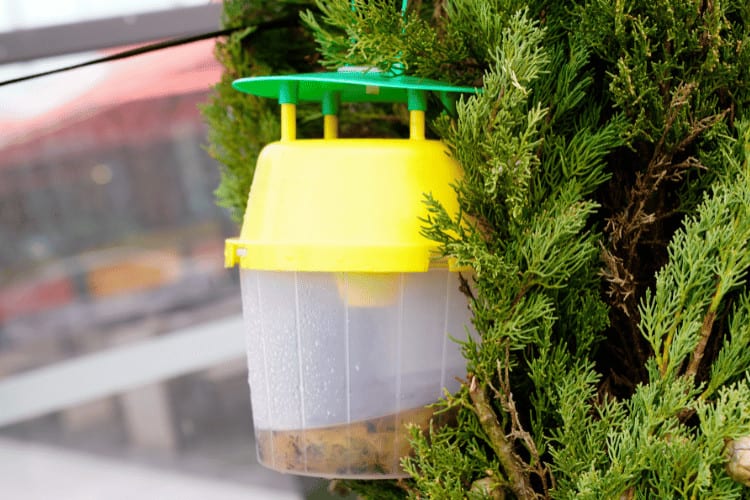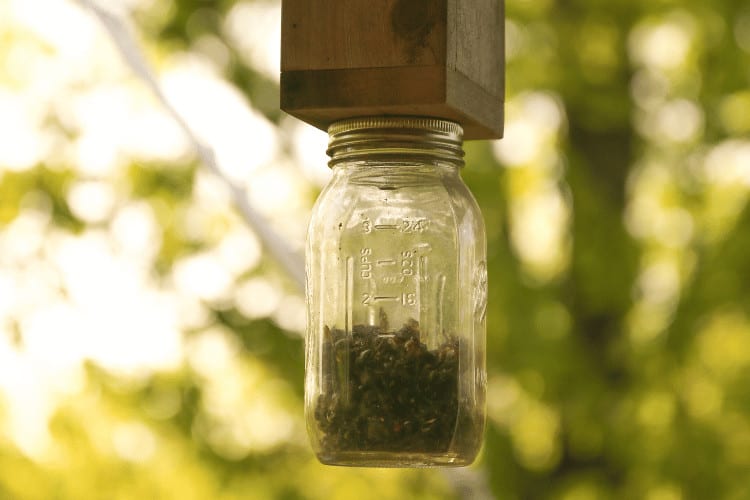Does Pine-Sol Attract Carpenter Bees?
Carpenter bees, known for their wood-boring habits, play a significant role in beekeeping. These industrious insects carve out nesting sites within wooden surfaces. They’re a fascinating subject for seasoned beekeepers and those new to the craft.
Yet, carpenter bees can be a nuisance. If they use your garden for collecting pollen, they can be a source of disturbance in your peaceful backyard.
Thankfully, there are many ways you can go about getting rid of the bees. For instance, you can use a scent to direct them to a different location.
This brings us to our question of the day, does Pine-Sol attract carpenter bees?
In this article, we’ll explore the behavior of these remarkable creatures. We’ll also cover how the scent of Pine-Sol can offer valuable insights and benefits to beekeepers.
Can You Use Pine-Sol to Trap Bees?

Most of us are familiar with Pine-Sol. It’s a household cleaning product known for its refreshing pine fragrance.
Over the years, the cleaner has gained a lot of attention because of its connection to carpenter bees. This leads many beekeepers like us to question why the scent is so alluring for bees.
Thankfully, the answer is quite simple!
Carpenter bees mainly live in wooden tunnels. So, it shouldn’t be a surprise that the smell of pine will pull them in.
The fresh wood scent signals that there’s a potential nesting site available. Because of that, in their quest for a new home, the bees will swing by the source of the smell.
Pine-Sol is particularly attractive to female carpenter bees.
What Other Scents Are Carpenter Bees Attracted To?
Aside from pine, there are a few other aromas that can grab the attention of carpenter bees. For starters, they seem to enjoy citrus fruits.
The sweet, zesty fragrance is similar to that of a blooming flower. So, the buzzing critter will assume that it’s in for the meal of its life.
Besides that, the scent of oregano, lavender, and human sweat can attract carpenter bees.
The last one may seem a bit odd, but it’s because of the high salt content. Bees need the mineral to ensure that their larvae grow quickly and healthily.

Where Do Carpenter Bees Hide?
Before we jump into how to trap bees, it’s crucial that you understand their nesting behavior so that you can effectively manage the critters without causing them harm.
Carpenter bees are solitary creatures that have distinct characteristics that set them apart. For starters, unlike honey bees, these insects don’t live in hives.
Instead, each bee will go out on its own and build a nest. These critters are notorious for their affinity for wooden structures. This is especially true for female carpenter bees.
They carve perfectly round holes into untreated wood to create nesting sites. This provides a safe haven for their brood.
The wooden holes can range from just a few inches to several feet deep. So, as an aspiring beekeeper, it’s best to learn how to identify these habitats.
That way, you can find them in a flash and set successful traps.
How Can You Use Pine-Sol for Carpenter Bee Management?
Since Pine-Sol can attract buzzing critters, it’s a useful tool for beekeepers. It’s an eco-friendly solution to manage the carpenter bee population in your backyard, though.

Let’s explore how you can use the household cleaner.
Step 1: Prepare the Pine-Sol Solution
The first step of the process is running to the store and grabbing a bottle of Pine-Sol.
You can use the cleaner as is for the trap, but it’s not a good idea. That’s because it contains a few harsh chemicals that may be harmful to carpenter bees. So, it’s best to dilute the Pine-Sol first before you use it.
Mix one part of the cleaner with one part of water to create a solution. This mixture will be fragrant enough to attract the critters without hurting them.
Step 2: Find the Carpenter Bee Holes
With the Pine-Sol solution in hand, you can start examining your backyard.
Begin by giving all wooden surfaces in the area a thorough once-over. This may include trees, benches, or even gazebos. Look for any holes that may signal a bee nesting site.
While you do that, be careful and try to avoid sudden movements. That’s because poking around a bee’s nest can be a dangerous adventure.
Step 3: Set Up the Carpenter Bee Trap
Once you find the nesting sites, you can set up your trap. Although, for this step, you’ll need an empty plastic container with a wide lid.
The opening should be big enough for bees to enter comfortably. You can use an old water bottle for this if you cut off the top half.
After that, fill your container about halfway up with the Pine-Sol solution. Then, place it directly next to the nesting sites you found.
Step 4: Monitor the Traps
The pine scent should start diffusing in the air a couple of hours after you set up the trap. However, it may take much longer for the carpenter bees to notice the fragrance.
So, all that you can do here is sit by and watch. Wait for a couple of days until the bees decide to relocate on their own.
If you’re in a hurry, you can use smoke to speed up the process. Yet, this may aggravate the bees if you don’t know what you’re doing.
Other than that, you can put some of the Pine-Sol solution in a spray bottle. Then, sprinkle the mixture all around the nesting sites.
This will catch the carpenter bees’ attention faster. Besides that, a spray bottle will give you much more control over the areas you target.
Step 5: Relocate the Bees
As soon as the bees move to the Pine-Sol trap, you can relocate them. You can move them to a different area in your backyard or in an apiary.
Wrapping Up
Does Pine-Sol attract carpenter bees?
Yes, the cleaning solution gives off a pine scent that’s alluring to the critters. Other fragrances that attract carpenter bees include citrus fruits and human sweat.
Thankfully, you can use these aromas to set traps for the buzzing insects. All you need is a small amount of cleaner and an old water bottle or spray bottle.
This can help you relocate the bees in a few days.
